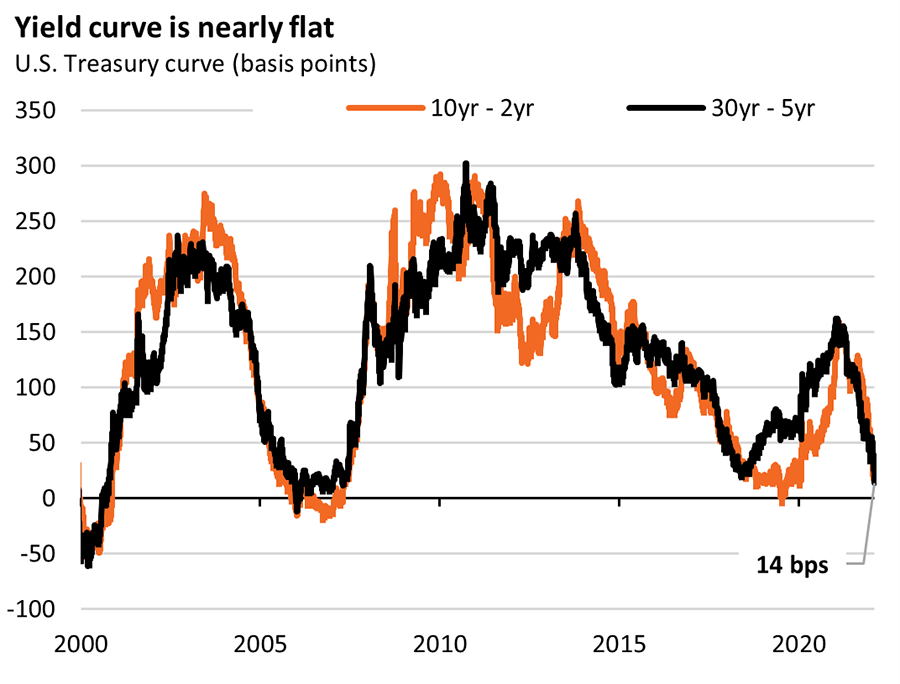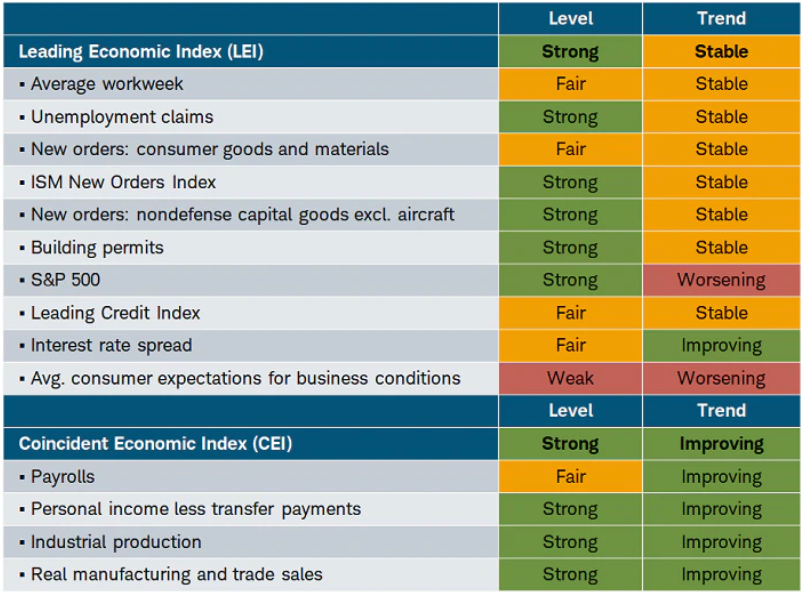Bonds are selling off around the world, and the Global Bond Aggregate index is down more than 10% since its peak in January, its worst drawdown on record. The bond market is flashing a warning sign that has correctly predicted almost every recession over the past 60 years: an inversion of the U.S. Treasury yield curve.
The existence of an inverted yield curve is a signal that investors are more nervous about the immediate future than the longer-term outlook. An inversion if the yield curve has preceded every recession since 1955, but in and of itself, the inversion does not guarantee a recession will occur.
The most closely watched part of the curve is the 2-year Treasury compared to the 10-year Treasury. On Tuesday, the 2- and 10-year yield curve inverted for the first time since 2019 after starting the year at a spread of 79 basis points between the two. The 5-year Treasury bond and the 30-year Treasury bond inverted on Monday for the first time since 2006.

What is the yield curve?
A yield curve is a line that plots interest rates (yields) of bonds with equal credit quality but different maturity dates. There are three main shapes of a yield curve: normal (upward sloping), inverted (downward sloping) and flat. A normal yield curve, or upward sloping, is indicative of economic expansion, while an inverted yield curve points to an economic recession.
With a normal yield curve, longer-maturity bonds have a higher yield compared to shorter-term bonds. For example, in a normal yield curve, a 2-year bond could yield 1%, a 5-year bond could yield 2% and a 10-year bond could yield 2.5%. The farther out one goes on the curve, the higher the yield. Conversely, an inverted yield curve slopes down, meaning that short-term interest rates are higher than longer-term interest rates. When the return of a 10-year bond is lower than that of a 2-year bond, for example, signs point to investors carrying a pessimistic outlook and a reluctance to commit money to longer-term maturities.
Why does an inversion in the yield curve matter?
The yield curve is one of a handful of leading economic indicators that are considered reliable gauges of turning points in business cycles. Yield curve inversions are often viewed as a cause of a recession, but really, they are symptomatic of the conditions that lead to an economic recession.
An inversion in the yield curve generally indicates a recession is coming, most often within six months to two years. It does not mean that stocks are about to sell off; historically, the stock market has not peaked until months after the inversion, as seen in the chart below.

The National Bureau of Economic Research (NBER) defines a recession as “a significant decline in economic activity that is spread across the economy and that lasts more than a few months.” The chart below lists the components of Leading Economic Index as well as Coincident Economic Index (CEI). NBER primarily monitors the CEI for recession indicators, but these provide a retroactive assessment and don’t tell us much about where we are headed. The unemployment rate is another lagging indicator; unemployment rates always have been near historic lows heading into recessions.
The chart also looks at the current level of 10 different leading economic indicators as well as the trends for each indicator. Consumer confidence has been waning as inflation runs high and the war in Ukraine continues into its second month. The S&P 500 trend is moving towards stabilization after the recent March lows, and the other leading economic indicators remain stable for now.

As the Fed continues to raise rates and investors anticipate tighter financial conditions, we will continue to watch the yield curve and other recessionary signals to determine how they may impact the stock market and your portfolios. While the Fed has finally announced it will raise rates to combat inflation, rates remain low by historical standards. The key message from the Fed is that it is focused on fighting inflation and is prepared to hike short-term interest rates steadily while reducing the balance sheet to attain its goals.
So, what can we learn from all this? This week, we saw the yield curve invert for the first time since 2019, but remember: A recession is not a foregone conclusion. Every recession has been preceded by a yield-curve inversion, but not every inversion of the yield curve has led to a recession. Furthermore, even if a recession occurs in the next six months to two years, the stock market may continue to experience positive returns.
From a portfolio perspective, we continue to adhere to the tried-and-true disciplines of diversification, periodic rebalancing and looking forward, while not making investment decisions based on where we have been. As we say each week, it is important to stay the course and focus on the long-term goal, not on one specific data point or indicator. In markets and moments like these, it is essential to stick to the financial plan. Panic is not an investing strategy. Neither are “get in” or “get out” — those are just gambling on moments in time. Investing is about following a disciplined process over time.
At the end of the day, investors will be well-served to remove emotion from their investment decisions; over a longer time horizon, markets tend to rise. Market corrections are normal, as nothing goes up in a straight line. Making market decisions based on what might happen may be detrimental to long-term performance. The key is to stay invested and stick with the financial plan. Markets go up and down over time, and downturns present opportunities to purchase stocks at a lower value.
It all starts with a solid financial plan for the long run that understands the level of risk that is acceptable for each client. Regarding investments, we believe in diversification and having different asset classes that allow you to stay invested. The best option is to stick with a broadly diversified portfolio that can help you to achieve your own specific financial goals — regardless of market volatility. Long-term fundamentals are what matter.
Sources: CNBC, CNN, Schwab, Investopedia, iCapital
This material contains an assessment of the market and economic environment at a specific point in time and is not intended to be a forecast of future events, or a guarantee of future results. Forward-looking statements are subject to certain risks and uncertainties. Actual results, performance, or achievements may differ materially from those expressed or implied. Information is based on data gathered from what we believe are reliable sources.
Using diversification as part of your investment strategy neither assures nor guarantees better performance and cannot protect against loss of principal due to changing market conditions.
Past performance is not a guarantee of future results.
The opinions expressed in this commentary are those of the author and may not necessarily reflect those held by Kestra Investment Services, LLC or Kestra Advisory Services, LLC. This is for general information only and is not intended to provide specific investment advice or recommendations for any individual. It is suggested that you consult your financial professional, attorney, or tax advisor with regard to your individual situation.
Securities offered through Kestra Investment Services, LLC (Kestra IS), member FINRA/SIPC. Investment Advisory Services offered through Kestra Advisory Services, LLC (Kestra AS) an affiliate of Kestra IS. CD Wealth Management and Bluespring Wealth Partners LLC* are affiliates of Kestra IS and Kestra AS. Investor Disclosures: https://bit.ly/KF-Disclosures
*Bluespring Wealth Partners, LLC acquires and supports high quality investment adviser and wealth management companies throughout the United States.





